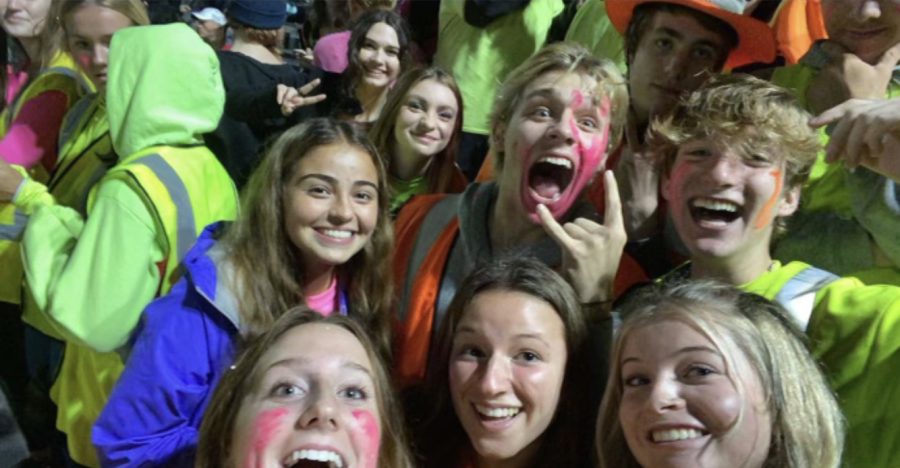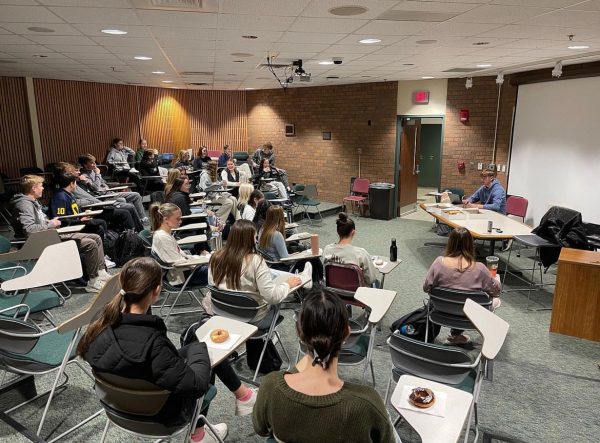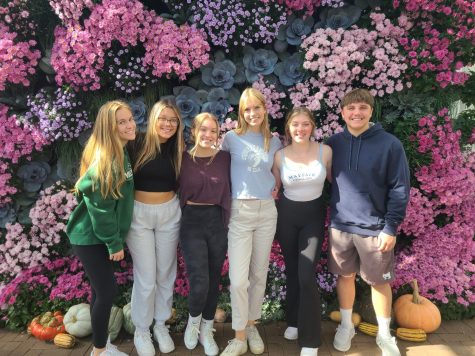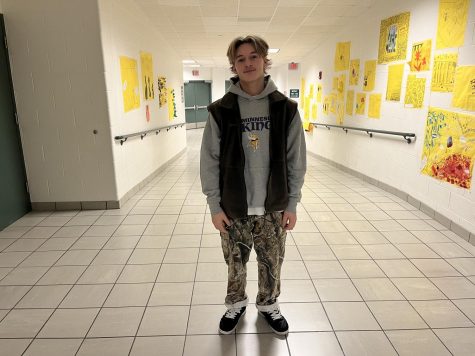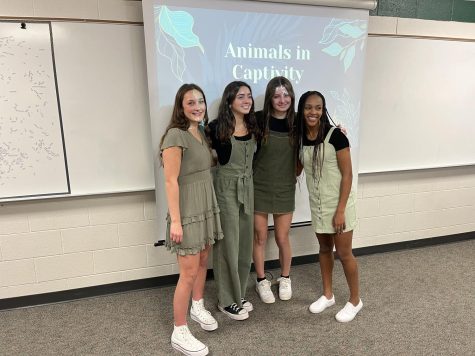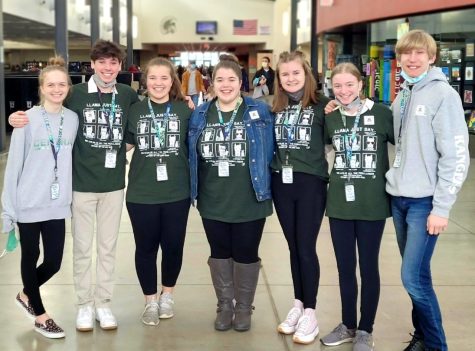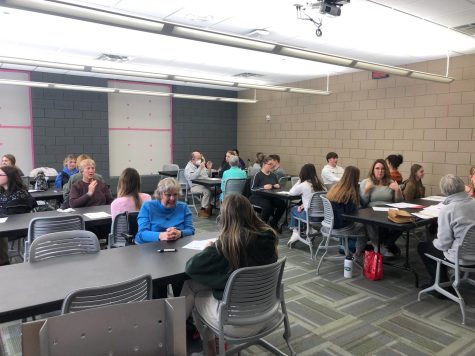Social Psychology brings students together in a new way
Some members of the Social Psychology class taking their weekly Survivor selfie.
During a Friday night football game, senior Katherine Hartman and a notable portion of her Social Psychology class could be found rallying together for a “Survivor” selfie.
Every Friday, the class watches the TV show Survivor during their class period because of its direct correlation to psychology. Surprisingly, this weekly screening has brought the students together on a new level, and their bond goes even outside of school.
“Friendships have started in this class,” Katherine said. “At the football games, we’ve been taking Survivor class selfies. So to everyone around us [from the class], we’ll be like, ‘Everyone get in this Survivor selfie!’”
The show itself—despite all of its entertaining and psychology-centered content—isn’t entirely responsible for bringing the class together in such a considerable way. What truly united these students was the participation and engagement that made watching the show the exciting experience that it is.
“Honestly, it’s really funny because the whole class is so into it,” Katherine said. “We’re all really invested. When [Mr. Pierce] puts it on, everyone’s watching; no one’s doing anything else. We’re all yelling [at the screen], saying ‘Really? What are you doing?’ We have inside jokes about it. It’s funny.”
Katherine has gotten to connect with her peers in the class on a level incomparable with other classes; she feels as though she has genuinely created new and stronger friendships within the walls of her Social Psychology classroom.
All of these opportunities for friendships, however, wouldn’t have been made possible if teacher Brian Pierce hadn’t inspired her to take this particular class in the first place.
“I took regular psychology my junior year,” Katherine said. “So I’ve had Mr. Pierce before; I took [Social Psychology] to have him [as a teacher] again.”
Pierce has been teaching Social Psychology for about five years here at FHC but has been an avid fan of the show Survivor for much longer. As he grew to form bonds with his students over the years, updates about his show of choice became standard; many students grew to know that Wednesday night was Survivor night in the Pierce household.
Knowing the show was created as a psychological social experiment, Pierce knew he had the opportunity of his teaching career. The idea to show his students the television program and analyze the psychological behaviors of each contestant started forming, and soon that idea rolled into motion.
“I’ve wanted to do this for a long time,” Pierce said. “I’ve always enjoyed Survivor; I’ve seen every episode. I think it’s the way my mind works with being able to read people and understand people and build relationships and then have the dilemma of trying to be friends with them and trying to defeat them at the same time. That conundrum is so intriguing to me. I’ve always wanted to incorporate it [into the class somehow], and then this year I decided, let’s give it a shot.”
His students have clearly grown to adore the watching and analyzing of this program along with many other aspects of the class.
Pierce makes an effort to foster a safe and open learning environment for his students to make education on the psychology of themselves and their peers as relaxed and secure as possible. In order for students to be properly instructed on the intense subject matter covered within the class, it’s essential for them to be able to be transparent about the topics.
“I just want to make sure they feel comfortable because sometimes we talk about things that are very personal,” Pierce said. “We talked about individual stressors for school. [I make] sure that they know that they’re in a class with people who have experienced similar things at some point in their life. It’s nice to be able to share that information.”
The friendships created within the classroom that have been carried past the walls can display how comfortable people feel to truly put themselves out there and outline necessary personal details of their life.
Senior Sophie Hartl has been especially impacted by the environment and togetherness of the classroom, showing that Mr. Pierce’s efforts have succeeded.
“I feel like Mr. Pierce makes it really comfortable for everyone to be able to talk about whatever their stressors are,” Sophie said. “Usually, I’m a quieter person, but in this class, I feel like I’m able to express myself a little bit more than in other classes.”
I feel like Mr. Pierce makes it really comfortable for everyone to be able to talk about whatever their stressors are. Usually I’m a quieter person, but in this class, I feel like I’m able to express myself a little bit more than in other classes. — Sophie Hartl
Sophie has appreciated every aspect of this class, including this ability to speak her mind and be heard. She completely agrees with Katherine that the class connectivity is the highlight of the experience.
“I like that there’s a lot of different people in the class,” Sophie said. “Freshman can take [the class] and so can seniors, so it’s a wide variety of people coming from all different backgrounds and different interests. It’s cool to see everyone’s perspectives.”
Clearly, the students of Social Psychology have learned a great quantity of content from Pierce and Survivor. From camaraderie to confidence, it is incredibly simple to gather that their outside lives have most definitely been positively impacted by the Social Psychology classroom.
If you were to ask Pierce, however, he would tell you that it is his life that has been impacted for the better.
“This particular class, I’ve learned a ton from,” Pierce said. “This is just a good class; I’ve been very fortunate. Teaching is hard, but there have been weekends where they will send me pictures of them all together and they’ll throw Survivor quotes on them and things like that. Sometimes this class just reminds me that people are good.”
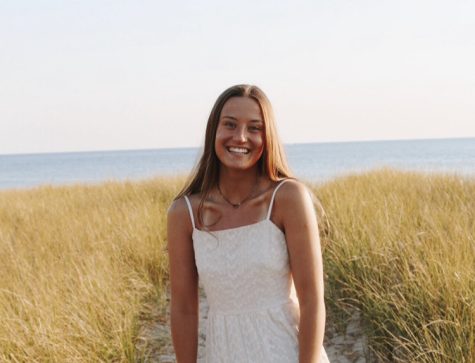
Katelynn is a senior entering her second and final year on The Central Trend. Besides writing, she loves singing, painting, and late-night bonfire chats...





















































































